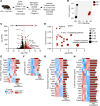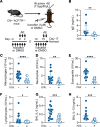CFTR negatively reprograms Th2 cell responses, and CFTR potentiation restrains allergic airway inflammation
- PMID: 40131363
- PMCID: PMC12128969
- DOI: 10.1172/jci.insight.191098
CFTR negatively reprograms Th2 cell responses, and CFTR potentiation restrains allergic airway inflammation
Abstract
Type 2 inflammatory diseases, including asthma, sinusitis, and allergic bronchopulmonary aspergillosis, are common in cystic fibrosis (CF). CD4+ Th2 cells promote these diseases through secretion of IL-4, IL-5, and IL-13. Whether the CF transmembrane conductance regulator (CFTR), the mutated protein in CF, has a direct effect on Th2 development is unknown. Using murine models of CFTR deficiency and human CD4+ T cells, we show that CD4+ T cells expressed Cftr transcript and CFTR protein following activation. Loss of T cell CFTR expression increased Th2 cytokine production compared with control cells. Mice with CFTR-deficient T cells developed increased allergic airway disease to Alternaria alternata extract compared with control mice. Culture of CFTR-deficient Th2 cells demonstrated increased IL-4Rα expression and increased sensitivity to IL-4 with greater induction of GATA3 and IL-13 compared with control Th2 cell cultures. The CFTR potentiator ivacaftor reduced allergic inflammation and type 2 cytokine secretion in bronchoalveolar lavage of humanized CFTR mice following Alternaria alternata extract challenge and decreased Th2 development in human T cell culture. These data support a direct role of CFTR in regulating T cell sensitivity to IL-4 and demonstrate a potential CFTR-specific therapeutic strategy for Th2 cell-mediated allergic disease.
Keywords: Adaptive immunity; Immunology; Inflammation; Pulmonology; T cell development; Th2 response.
Conflict of interest statement
Figures







References
-
- Shanthikumar S, et al. Inflammation in preschool cystic fibrosis is of mixed phenotype, extends beyond the lung and is differentially modified by CFTR modulators [preprint]. https://10.1136/thorax-2024-221634 Posted on Thorax February 10, 2025. - DOI - PubMed
MeSH terms
Substances
Supplementary concepts
Grants and funding
LinkOut - more resources
Full Text Sources
Medical
Research Materials

